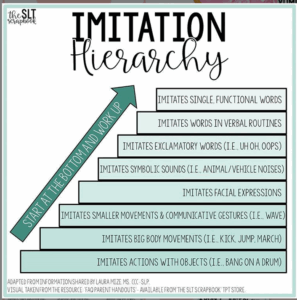Have you ever noticed challenges with your toddler responding to their name, making eye contact, or using simple gestures like waving hi or bye? Does your toddler like to share experiences with others, or do they prefer to play alone? If any of these questions have crossed your mind as a parent, it may indicate that your toddler has difficulty with social communication.
According to the American Speech-Language-Hearing Association (ASHA), social communication is “how and why we use language to interact” with our family and peers (“American Speech,” n.d.). There are many reasons your toddler could be facing challenges with social communication. For example, social communication difficulties in conjunction with “restrictive, repetitive patterns of behaviors, interests, or activities” could indicate early signs of autism spectrum disorder (“What is autism,” n.d.). If you have any concerns related to how your child is socially interacting with others at home or out in the community, it is always best to contact a professional to determine ways to support your toddler.
According to ASHA, social communication skills that toddlers typically develop between ages birth to three are listed below.
Birth to 12 Months
- prefers looking at human face and eyes
- prefers listening to human voice
- looks for the source of voice
- differentiates between tones of voice (e.g., angry, friendly)
- smiles back at the caregiver
- follows the caregiver’s gaze
- participates in preverbal vocal turn-taking with the caregiver
- vocalizes to get attention
- demonstrates joint attention skills (sharing attention)
- uses gestures to make requests and direct attention
- plays simple interactive games, such as peekaboo
- seeks comfort or a safe haven from the caregiver
- expresses feelings
- develops object permanence
- discriminates facial expressions
- fears strangers
- develops relational memory (faces/voices)
- changes behavior to achieve a goal
- imitates gestures or oral movements
12–18 Months
- develops a range of communicative intentions (e.g., requesting, protesting, commenting)
- brings objects to show caregivers
- requests by pointing and vocalizing
- solicits attention vocally
- practices vocal inflection
- says “bye” and other ritualized words
- protests by shaking head and/or saying “no”
- supplements gestures with verbal language
- is aware of the social value of speech
- responds to others’ speech with eye contact
- demonstrates sympathy, empathy, and sharing nonverbally
- shows joy, fear, and anger
- displays an increase in autonomy
- resists control
- co-regulates interactions
18–24 Months
- uses single words to express intention
- uses single and paired words to command, indicate possession, express problems, and gain attention
- uses I, me, you, my, and mine
- participates in verbal turn-taking with a limited number of turns
- demonstrates simple topic control
- interrupts at syntactic junctures or in response to prosodic cues
- demonstrates secure or insecure attachment pattern
- exhibits emotion and behavioral regulation
- demonstrates an increase in autonomy
- develops emerging implicit perceptual access reasoning
- shows daily routine schemes in play
24–36 Months
- engages in short dialogues
- verbally introduces and changes topic
- expresses emotion
- begins to use language in an imaginative way
- relates own experiences
- begins to provide descriptive details to enhance listener understanding
- uses attention-getting words
- clarifies and asks for clarification
- uses some politeness terms or markers
- begins to demonstrate some adaptation of speech to different listeners
- can deceive and detect deception
- understands that others may feel differently than oneself
- follows rules
- shows common but not daily schemes in play (e.g., doctor, shopping)
- uses embedded requests” (“American Speech,” n.d.).
You can also find these social communication milestones listed above on ASHA’s website at the following link. If you have any concerns related to your child’s social communication skills, please contact Rainbows United Infant Toddler Services for a free developmental evaluation at: 316.945.7117 extension 134.
By: Makenzie Kozar MA, CCC-SLP, Rainbows United, Inc.
References:
American Speech-Language-Hearing Association. (n.d.-a). Social Communication. American Speech-Language-Hearing Association.
American Speech-Language-Hearing Association. (n.d.-b). Social Communication Benchmarks. American Speech-Language-Hearing Association.
What is autism?. Autism Navigator. (n.d.).
Image used with permission from The SLT Scrapbook.


